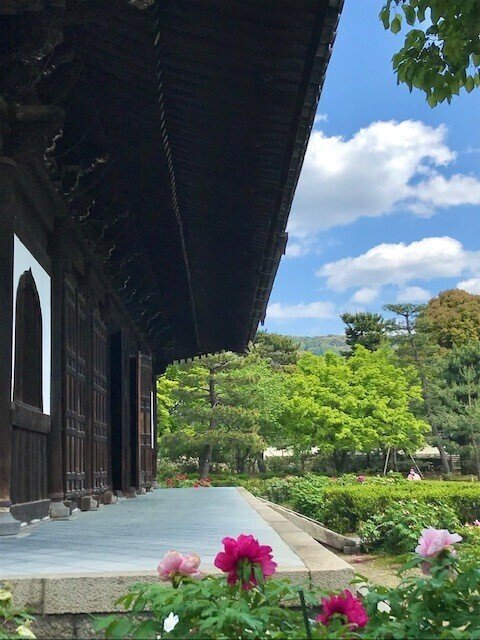
建仁寺 法堂の周りを百花の王が見守る The King of Hundred Flowers watches over the Kennin-ji Temple
「ボタン(牡丹)」という和名は、中国の花名「牡丹(ボウタン)」をそのまま使い、中国語読みの「牡(ボウ)」を日本語読みにしたものである。
牡丹は、絹のような花びらが幾重にも重なる優雅でふくよかな花姿が特徴で、中国では「花王」「花神」「富貴花」とも称されている。日本でも「富貴花」「百花王」「花王」「花神」「花中の王」「百花の王」などと呼ばれ、花の中でもこれほど多くの別称をもつ花も珍しい。
The Japanese name "Botan(Peony)" is a Japanese reading of the Chinese reading "Boutan(Peony)", using the Chinese flower name "Peony" as it is.
Peony is characterized by its elegant and plump flower appearance with many layers of silky petals, and is also called "Kao," "Kashin," or "Fukika" in China. Even in Japan, it is called "Fukika", "Hyakkaou", "Kao", "Kashin", "King of flowers", "King of hundred flowers", etc., and among the flowers, flowers with so many different names are rare.
桜が終わるころに色とりどりの大輪の花が咲き始める。牡丹と言えば美人の比喩に使われるほど色彩豊かで、花王の風格を感じさせる花。その牡丹がモノトーンのイメージをもつ禅寺などでよく見かけ、その取り合わせが絶妙である。
Around the end of the cherry blossoms, large colorful flowers begin to bloom. Speaking of peony, it is so colorful that it is used as a metaphor for beautiful women, and it makes you feel the style of Kao. The peony is often seen in Zen temples, which have a monotone image, and the combination is exquisite.
先日訪れた建仁寺の法堂の周りには多種多様の牡丹が植えられている。法堂の窓や白壁を背景にした大輪が見事に映える。本尊である釈迦如来立像や天井画の双龍図がある法堂を百花の王が見守っているかのようだ。
A wide variety of peonies are planted around the temple of Kennin-ji, which I visited the other day. The large flowers against the background of the windows and white walls of the temple shine beautifully. It seems that the King of Hundred Flowers is watching over the temple with the statue of Shaka Nyorai, the principal idol, and the Ssangyong figure on the ceiling.




レポート & 写真 / 渡邉雄二 場所 / 建仁寺 法堂 Reported & Photos by Yhui Watanabe
よろしければサポートお願いします。日本の伝統文化に関心を寄せています。若いころに文化圏の異なる地域の方たちとの交流で日本のことをあまりにも知らなかったことに気づかされ、それがきっかけで広く浅く学んでいます。拙いレポートですが、お目に留めていただければ幸です。
